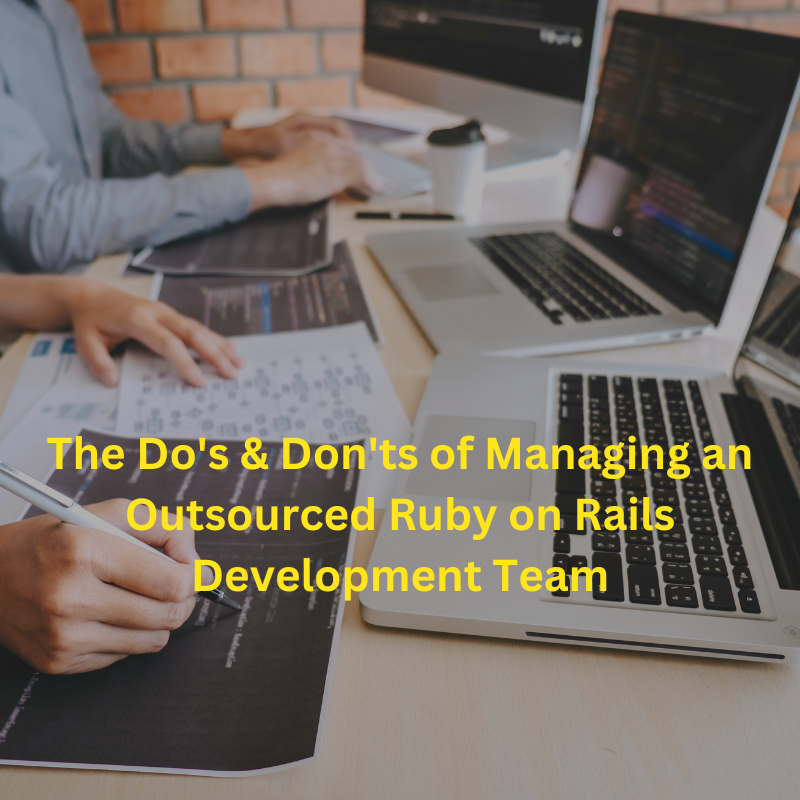The Do’s & Don’ts of Managing an Outsourced Ruby on Rails Development Team
Outsourcing Ruby on Rails development is becoming increasingly popular as businesses look to take advantage of the cost savings and flexibility that remote teams can bring. However, managing a remote team of developers isn’t always easy.
It requires careful planning and communication to ensure that projects are completed within budget and timeline. Let’s look at some do’s & don’ts for managing an outsourced Ruby on Rails development team.
For businesses looking to leverage the power of Ruby on Rails development without having to build an in-house team, outsourcing can be a great option. But it’s important to know how to manage an outsourced team effectively so that your business gets the most out of the collaboration. Here are a few do’s and don’ts for managing an outsourced Ruby on Rails development team.
What is Ruby on Rails Development?
Ruby on Rails, often just referred to as Rails, is an open-source web application framework written in the programming language Ruby. It is designed to simplify and speed up the process of creating web applications and websites.
Ruby on Rails development is a type of software development that uses the programming language Ruby and the web application framework called “Rails” to create dynamic web applications.
With Rails, developers are able to quickly create powerful web applications by using a series of pre-built tools and libraries that are available in the framework. This makes it easier for developers to build complex applications without having to write large amounts of code from scratch.
Benefits of Using Ruby on Rails 
One of the main benefits of using Ruby on Rails for development is that it allows developers to save time by not having to write large amounts of code from scratch. As mentioned above, there are several pre-built tools and libraries available within the framework which can help reduce a lot of manual coding work.
Additionally, because it’s an open source platform, there’s also a lot of resources available online which can help with debugging issues or finding solutions for unique challenges you may encounter during your development process. Finally, since it’s such a popular platform, there are also many experienced developers who can offer help or guidance if needed.
Limitations of Using Ruby on Rails
Despite its many benefits, there are some drawbacks associated with using RoR for web development projects as well. Its lack of scalability means that businesses will need to switch frameworks if their needs exceed what RoR can provide in terms of speed or performance capabilities down the road.
Additionally, because it uses a single language (Ruby), applications built with RoR are often difficult for non-developers to understand or maintain without additional help from a developer familiar with the framework.
Finally, while there are plenty of resources available online related to learning and troubleshooting issues with RoR, businesses should keep in mind that they may need additional assistance if they encounter anything outside of what these resources provide or if their project requires something more bespoke than existing solutions offer.
Managing an Outsourced Ruby on Rails Development Team
Working with an outsourced development team can be a great way to get the job done quickly and efficiently. However, managing such a team requires skill and knowledge. Here are some do’s and don’ts when it comes to managing an outsourced Ruby on Rails development team.
Do’s of Managing an Outsourced RoR Development Team
1. Do your research
Before hiring a RoR development team, it’s important to do your research on who you’re going to hire and their capabilities. You need to assess the skill level of the team, their experience with RoR, their track record, and what type of support they offer when something goes wrong.
2. Do Clearly Define Expectations & Goals
When working with any outside development team, it is important to set clear expectations from the start. This includes outlining specific deliverables and timelines as well as any specialized expertise or skills you expect from your developers. Additionally, you should also establish project goals so that both parties have a common understanding of what you are trying to achieve. A well-defined scope of work will help ensure that your project runs smoothly and efficiently.
3. Do Establish Clear Communication Protocols
Communication is an essential part of any successful project, especially when working with an outsourced development team. Establishing a clear communication protocol in advance helps ensure everyone is on the same page throughout the entire process.
This might include setting up regular meetings or check-ins, establishing channels through which questions can be asked or issues addressed, or clarifying who is responsible for making decisions about the project. Having this infrastructure in place will help ensure any issues are addressed quickly and effectively so your project stays on track and avoids costly delays or miscommunications down the line.
4. Do Assign Ownership & Responsibility
Creating ownership and responsibility within your project helps ensure that tasks get completed in a timely manner and at the highest possible quality. This can be done by assigning one or multiple people from the in-house team as “owners” of each task, who are then responsible for giving feedback, answering questions, and signing off on deliverables. This way, everyone is aware of who is responsible for what part of the project at any given time.
5. Do Ask Questions & Provide Feedback
It is important to stay involved in your project’s progress by asking questions and providing feedback throughout the process. Doing so will help keep things running smoothly while also allowing you to make sure that you are getting what you need out of the collaboration with your outsourced team. Additionally, feedback can help ensure that communication stays open between both teams and allows for changes or adjustments if needed.
6. Do create a timeline for completion
It’s important to have realistic timelines for completing each stage of the project so that expectations are managed correctly and there are no surprises at the end of the project timeline. Make sure all deadlines are communicated clearly and regularly updated throughout the project timeline as needed.
Don’ts of Managing an Outsourced RoR Development Team
1. Don’t Skimp On Quality Control
It can be tempting when outsourcing a project to focus solely on cutting costs, but this approach often leads to subpar results. While it is important to stay within budget, it’s even more important to make sure your final product meets quality standards before releasing it into the wild! Make sure you have a plan in place for testing each stage of the development process and addressing any issues before they become bigger problems down the road.
2. Don’t Be Afraid To Communicate Changes Or Updates
Things change all the time—and that’s okay! It’s normal for projects to have their scope tweaked or adjusted as they progress along in order to meet changing needs or goals. When this happens, it’s important not to be afraid to communicate those changes or updates with your outsourced team so they can adjust accordingly. This will help keep everyone on the same page while ensuring that no steps are missed when making any necessary adjustments or changes.
3. Trying To Do Too Much At Once
When managing an outsourced Ruby on Rails development team, it can be tempting to try and do too much at once. This can lead to things getting overlooked or forgotten about, which could result in delays in delivery or increased costs due to rework or duplication of effort. Instead of trying to cram as much work as possible into each sprint cycle, focus on delivering one feature at a time so that each task has been thoroughly tested before moving onto the next one.
4. Don’t Assume They Know Your Business
When working with an outsourced team, it’s important to remember that they may not understand every aspect of your business or industry as well as you do. You may need to spend extra time explaining what certain terms mean or why certain decisions have been made in order for them to understand the context of their work. Additionally, it’s important to keep in mind that different cultures may have different approaches to problem solving, so be sure to discuss any potential conflicts before they arise.
5. Don’t Forget About Testing
Test early and test often! Even when working with experienced developers, there are no guarantees that things won’t go wrong during development—and if something does go wrong, the sooner you find out about it the better! Make sure your team has testing procedures in place from the start so any problems can be identified and addressed quickly and efficiently.
Conclusion
Outsourcing Ruby on Rails development can be very beneficial for businesses looking to save time and money while still getting high-quality results.
However, managing a remote development team requires careful planning and effective communication protocols if you want your projects to run smoothly and efficiently without sacrificing quality control. By following these tips you can ensure success with your remote Ruby on Rails developers every time.
Working with an external development team has many advantages; however, it also requires careful management if you want your project to succeed.
By following these do’s and don’ts of managing an outsourced Ruby on Rails development team, website owners can ensure their projects come in on time and under budget while avoiding costly mistakes along the way.












